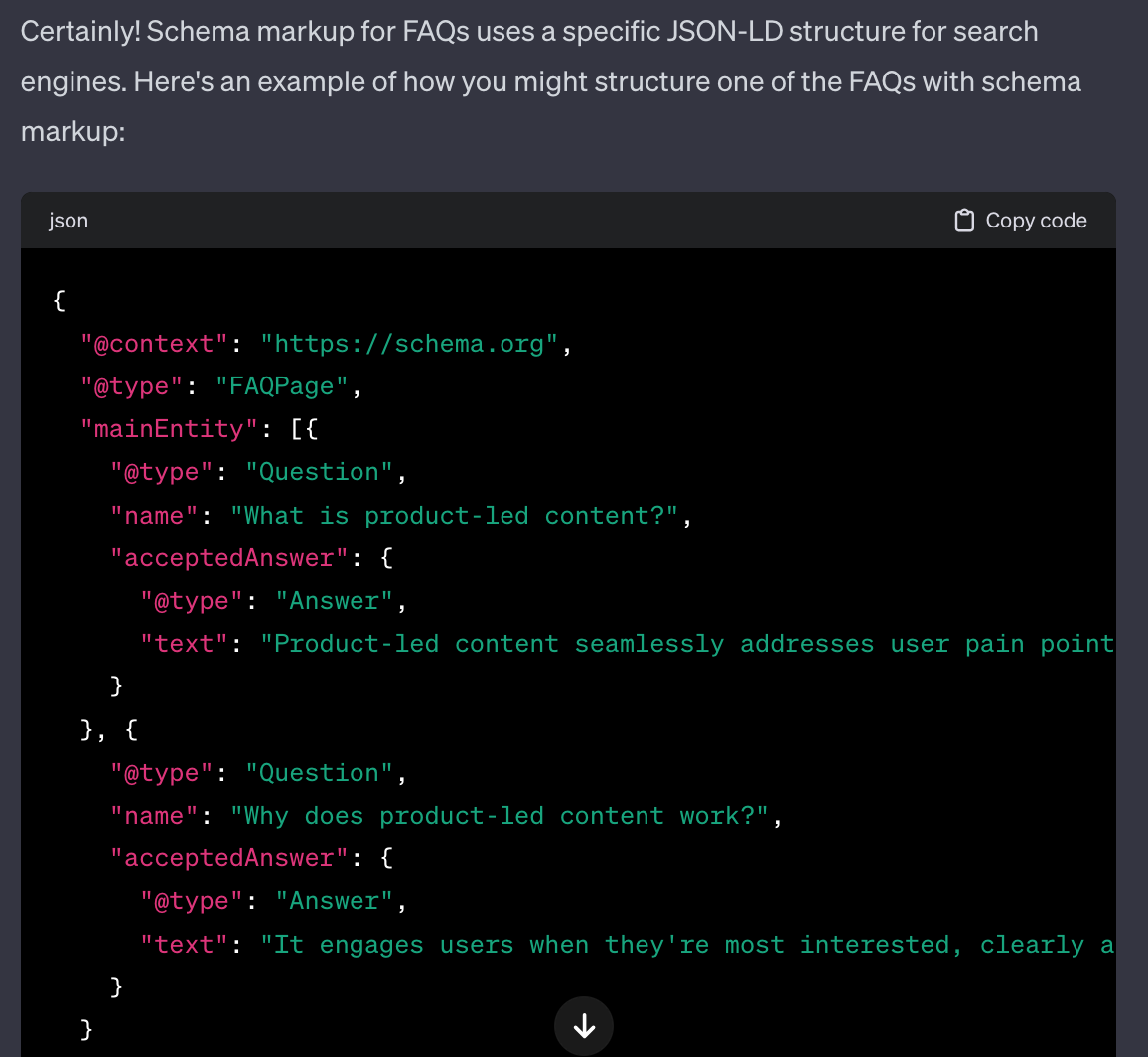The Best AI SEO Strategy for 2024
Get weekly strategy insights by our best humans

As we covered in previous posts, AI isn’t a good replacement for a seasoned content team. However, you can use AI to speed up some stages of your content lifecycle, enabling you to produce better content more frequently.
At this point, you may be wondering: what would responsible AI-driven SEO look like? That’s exactly what we’ll explore in this post. But first, a disclaimer.
There’s No Good “AI-Driven” Content
“AI-driven” content shouldn’t be AI-driven at all. AI can assist, expedite, and help standardize processes. But GPT shouldn’t be dragging you by the nose. You (or an expert you trust) should be in control of your SEO strategy. Only a well-informed human can have the perspective and creativity that a successful SEO program requires.
Sometimes, companies will come to us and request an SEO audit, to understand a drastic and seemingly unjustified drop in traffic. In the large majority of cases, this drop in traffic came after a fast and significant traffic surge, caused by the mass publishing of AI-generated content. Often, this content brought little to no leads and had an overall negative impact on the brand’s perception.
AI content doesn’t yield lasting results. But, if done with enough brute force, it can bring an unimpactful but superficially impressive boost in traffic. That’s why most SEOs are swearing by it.
Now that we’ve gotten this out of the way, let’s dive into our model AI SEO strategy.
AI SEO Strategy Framework
.jpeg)
You can implement AI across your content lifecycle - but what should that lifecycle look like?
There’s no standardized content lifecycle to refer to. However, we can share what our content lifecycle looks like. It’s usually something along these lines:
- Ideation - At this stage, we brainstorm potential content ideas (working directly with our client’s marketing/support/sales leaders), and we use keyword research to select and validate those ideas.
- Briefing - Once the best ideas have been selected, we produce a SEO brief. This brief combines technical and keyword recommendations with the context the writer’ll need to produce a high-value piece.
- Production - This stage is pretty self-explanatory. But it’s usually the longest stage, including 3 substages: Writing, editing & graphic design (if infographics are needed).
- Distribution & repurposing - Once the content goes live, it’s distributed and repurposed to nourish several marketing channels.
- Optimization - We monitor our content’s positioning and freshness, and re-optimize it as often as necessary. We’re so big on revamping that we’ve created a re-optimization checklist to help teams adopt revamping.
Let’s see how AI can expedite processes across these different stages.
How to use AI for content ideation
300x_copy.jpeg)
You can leverage AI during the brainstorming stage of content ideation. As always, AI is better leveraged as a helper rather than a leader.
Let’s say we run Stripe’s blog (full disclosure: we don’t), and we want to create 10 bottom-of-the-funnel ideas for early-stage startup financial leaders.
We can go to GPT-4 and ask:
“Give me a list of 10 bottom-of-funnel ideas for Stripe's blog, targetting early-stage startup revenue leaders.”
GPT-4 will reply with a list of ideas, and a brief explanation of what each post would be about.

Recently, YouTuber Tom Scott asked GPT to provide content ideas for fellow content creators. Most of these ideas were a good foundation but needed “a twist”, something attention-grabbing and unique.
That principle stands for all types of AI-assisted brainstorming. But AI can help you combat writer’s block and capture new ideas anyway. Just don’t take its outputs at face value.
Using AI for keyword sorting
While AI is unreliable for keyword research (more on that later), it can be used for sorting keywords by search intent, sentiment, or any other coincidence.
You just have to feed your keywords to GPT-4 and ask it to “sort these keywords by search intent.” You can also ask it to organize the output on a table, with the headings “keyword” and “intent”.

Use AI to enrich your content brief
Our content briefs usually have 5 sections:
- A brief introduction outlining the piece’s context & goals
- A list of target keywords (sorted by difficulty and monthly search volume)
- Top competitors (SERPs and otherwise)
- Recommended interlinks
- FAQs/People also ask
.jpeg)
We recommend using AI to gather frequently asked questions, using prompts like:
“What are the 10 most common questions [user persona] have about [topic]?”
For instance, “What are the 10 most common questions early-stage startup revenue leaders have about payment processors?”.
How to use AI for content repurposing
.jpeg)
While we don’t recommend replacing your content team with ChatGPT, GPT can be a great tool to lighten your content team’s workload. Using GPT to repurpose content allows teams to take their best ideas across social channels, at speed.
You can be as generic or as detailed as you want to. For instance, using a GPT-based bot that has internet access, we turned our post on how-to start creating product-led content into a LinkedIn post. Here’s the prompt we used:
Turn this post https://www.postdigitalist.xyz/blog/product-led-content-starter into a LinkedIn post. Write it in proficient American English, using a conversational tone. Focus on the pain point the post solves, and include a CTA. Keep it under 200 words.
And here’s the output:

This post includes too many emojis and doesn’t really match our brand tone. But it’s a good foundation, it just requires a bit of editing and it’ll be ready to go live.
How to optimize your technical SEO with AI
You can also use AI to:
- Write image alt tags
- Generate schema markup
Both of these tasks contribute to your content’s findability and accessibility.
To write an image alt tag with GPT-4, just upload your image and ask GPT-4 to describe it in under 140 characters.
Here’s a simple example.
We uploaded this picture:

And GPT-4 produced this output:
“A majestic Bengal cat lounges atop a scratching post, eyes squinting, against a backdrop of vertical blinds.”
That cat’s certainly majestic, so this alt tag receives a passing grade. However, consider that you can (and probably should) specify your target keywords.
When it comes to schema tags, you can go for something simple, or be a bit more ambitious. For instance, you can ask GPT-4 to isolate a series of questions and answers from your post, and then structure them with schema.
The first step would be solved with a single prompt. Here’s an example:
Using this post as a source, create a list of FAQs: [Post URL]
Next, ask it GPT-4 to “Structure these FAQs using schema markup.” The result will look something like this:

When Not to Use AI for SEO
These 5 use cases are the only SEO AI applications we recommend. We’re sure you’ll come up with other ideas - but they should be within those coordinates. We don’t recommend using AI for:
- Keyword research
- Content writing
Keyword research
In spite of faking it convicingly, GPT and similar LLMs don’t have real, criterious access to keyword data. As we mentioned earlier, you can use AI tools to understand at-scale trends and common user needs. But don’t forget to analyze their suggestions through your SEO tool of choice, and handpick the best keywords for your strategy.
Content writing
AI-generated content is usually generic, bland, and easily detectible. It has no lasting power or true competitive advantages, even if it causes a surge in traffic. That surge, as we mentioned earlier, will most likely be unsubstainable and have no business impact. So, it’s best to leave content writing to content writers, and use AI for other, “assistance” tasks, not “creation” tasks.
Unlock SEO Potential, Minimize Risk
Unsure about your SEO program? Tired of spending without seeing results? Before committing to a retainer, let's assess the basics. We'll examine your content's quality & impact, to tailor a plan that truly benefits you. Step forward with clarity. Request an in-depth SEO audit today.
Pss, our strategies are 100% modular. We’ll give you something high-value, whether you choose to take things in-house, work with us, or hire another agency.

